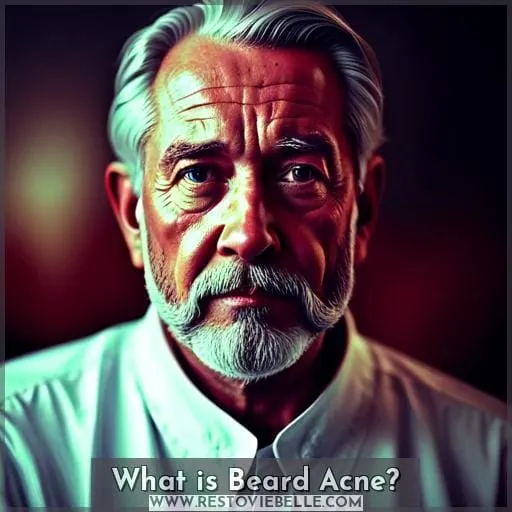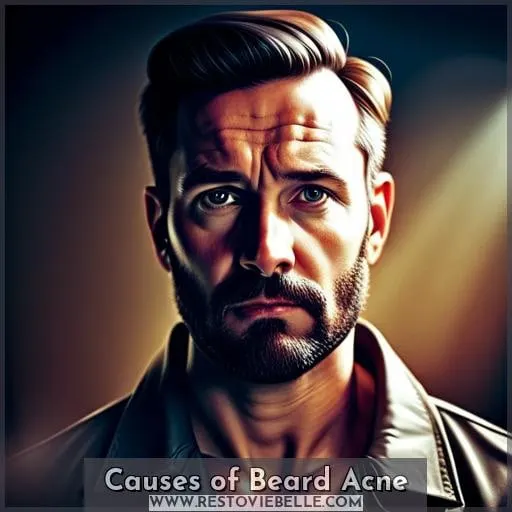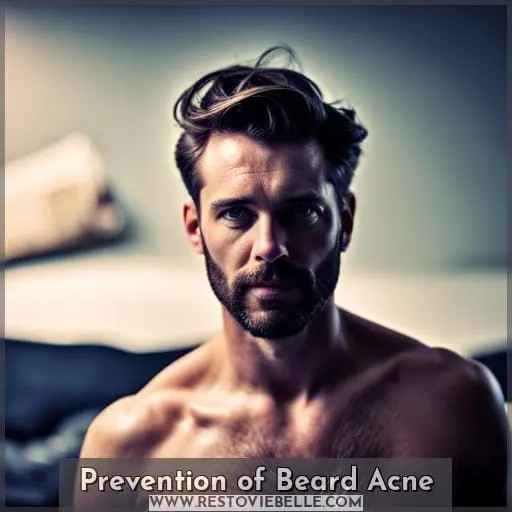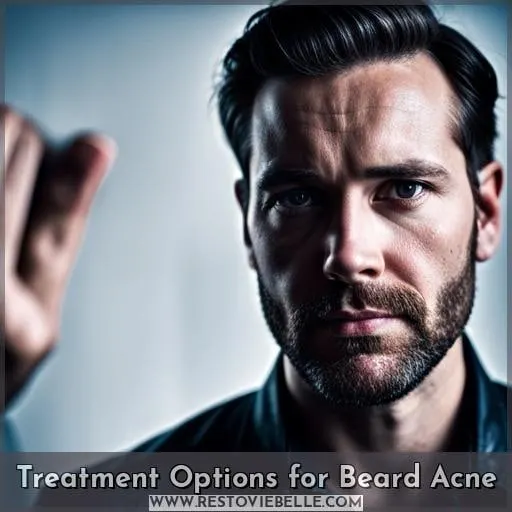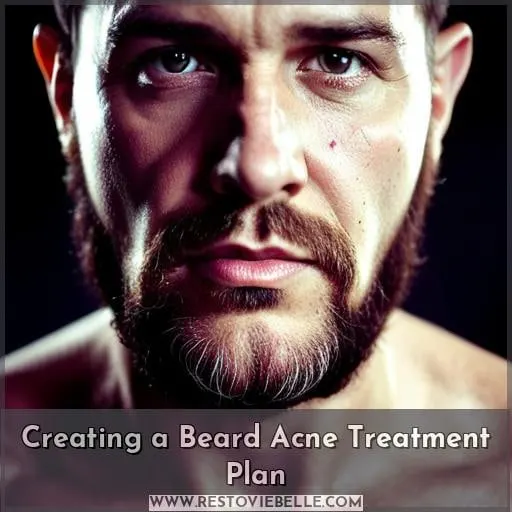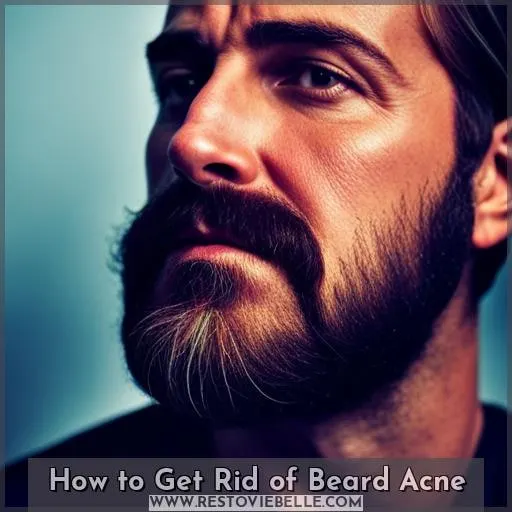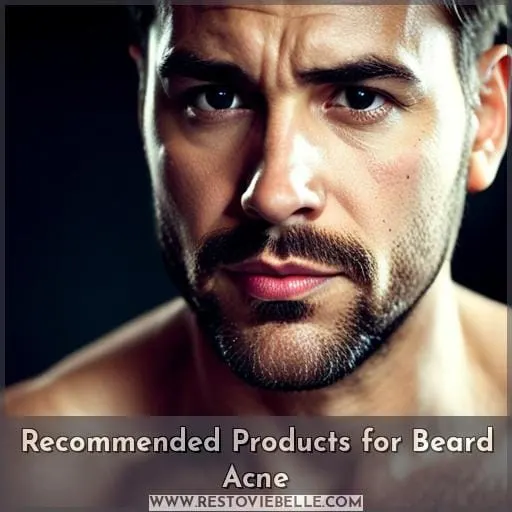This site is supported by our readers. We may earn a commission, at no cost to you, if you purchase through links.
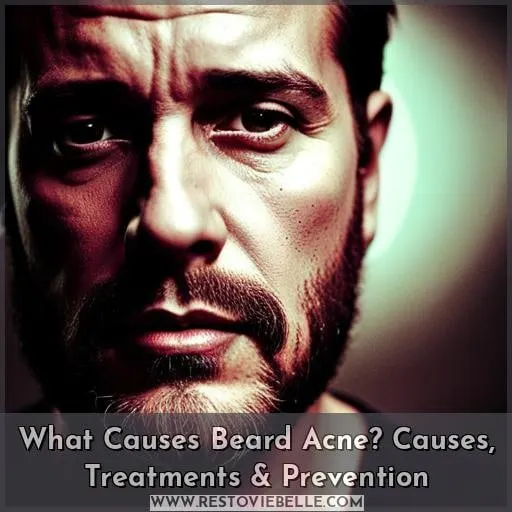 Are you tired of dealing with beard acne? Trying to figure out what’s causing it and how to prevent it can be a challenge, but you’re not alone. Many men suffer from the same problem: pimples, bumps, and other skin irritations in their facial hair that are making them feel self-conscious about their appearance.
Are you tired of dealing with beard acne? Trying to figure out what’s causing it and how to prevent it can be a challenge, but you’re not alone. Many men suffer from the same problem: pimples, bumps, and other skin irritations in their facial hair that are making them feel self-conscious about their appearance.
In this article, we’ll cover the causes of beard acne as well as treatments and prevention methods so that you can get rid of your unwanted breakouts once and for all.
Table Of Contents
Key Takeaways
- Beard acne is caused by clogged pores and bacterial infections.
- Improper shaving techniques and dull razors can lead to ingrown hairs and inflammation.
- Moisturizing after shaving helps prevent razor burn and ingrown hairs.
- Chemical exfoliants like lactic acid and glycolic acid can prevent clogged pores.
What is Beard Acne?
Beard acne is a frustratingly common issue, but with the right care and knowledge, you can maintain a healthy beard and clear complexion. Hair care for darker skin tones should include regular washing using mild shampoo.
Use razors sharpened regularly to avoid irritation that leads to folliculitis or bacterial infection of the hair follicles, which causes beard acne.
Genetic factors may contribute to sparse or thin facial hair growth, while medications like Xeljanz can help reduce related hair loss. In addition, moisturize daily after shaving to protect against razor burn and ingrown hairs.
Use lightweight gel-based products as they are less likely to clog pores than heavier creams.
Finally, be sure not only to practice proper hygiene when caring for your face and beard but also remember that prevention is key. Use clean linens when touching your face and regularly exfoliate with chemical exfoliants such as lactic acid and glycolic acid rather than harsh scrubs.
Causes of Beard Acne
Beard acne can be caused by a variety of factors, from skin irritation to sparse or spotty hair growth. Ingrown hairs, beard dandruff, bumps in the beard, and even pimples all pose potential risks for men looking to maintain a healthy facial appearance.
To combat these issues, it’s important to take preventative measures against skin irritation and practice proper hygiene when shaving.
Skin Irritation
You may experience skin irritation from shaving, which can be especially uncomfortable if you have dense or curly facial hair. According to a survey conducted by the American Academy of Dermatology, nearly 75% of men who shave regularly experience some form of skin irritation due to this activity.
Irritant contact dermatitis is caused by dull razors and improper contours increasing risk, while chemicals and fragrances in products heighten sensitivity. To prevent ingrown hairs, pre-shave oil, new razors, and showering before are key.
Ingrown Hairs
Shaving incorrectly or with a dull razor can result in ingrown hairs and inflammation. To avoid beard itching, use a pre-shave oil to lubricate and protect the skin before shaving. Comb your beard regularly with a boar bristle brush to reduce dandruff control and promote hair growth.
Use topical treatments such as salicylic acid or benzoyl peroxide acne creams for any existing bumps. These also help prevent future breakouts caused by sebum oil build-up. When you shave, go against the grain, but be careful not to press down too hard on your razor, which can cause irritation and razor burn! Finally, always keep spare razors handy so that you’re never caught without one when needed.
Sparse or Spotty Hair Growth
Genetic factors can contribute to the development of sparse or spotty beard growth, so it’s important to look into potential treatments like Xeljanz.
To prevent hair loss and promote healthy growth, consider incorporating Aloe Vera and Tea Tree Oil in your grooming routine. Using a sharp razor blade or electric razor with pre-shave oil will help reduce irritation on sensitive skin and avoid ingrown hairs.
If symptoms persist, a dermatologic approach may be needed. Acne treatments such as salicylic acid combined with medicated shampoos containing ketoconazole are effective solutions for dandruff and bumps.
For an improved facial appearance, regular brushing of the beard is recommended. This evens out product distribution while dramatically reducing the risk of inflammation.
Beard Dandruff
Discover how to tackle unsightly dandruff in your beard with these simple tips. Seborrheic dermatitis, caused by Malassezia yeast, is the usual culprit of beard dandruff.
Exfoliating scrubs and chemical acids like lactic or glycolic acid are also effective for removing dead skin cells that cause itching and flaking.
Medicated face wash, topical treatments like benzoyl peroxide or salicylic acid may also be prescribed for more severe cases along with skincare products specifically formulated for facial hair care such as moisturizers specially designed for the beard area which reduce oil production while keeping it hydrated without weighing your whiskers down.
Bumps in the Beard
Regular checks are needed to identify benign or potentially cancerous bumps in your beard. Cleansing and exfoliating, as part of a regular grooming routine, can reduce the risk of skin irritation due to sparse hair growth.
Shaving with the grain instead of against it also helps prevent pseudofolliculitis barbae (PFB), commonly known as razor bumps. Laser therapy may be beneficial for scarring caused by ingrown hairs or acne breakouts from shaving too close on occasion.
Speak with a dermatologist about medical options like topical treatments that will work best for you if over-the-counter products do not help address your facial hair issues and skin care needs related to beard maintenance.
Pimples
Pimples can be an unwelcome guest on your facial hair, so take a proactive approach to prevent and treat them.
- Wash your beard regularly with a medicated shampoo to reduce dandruff and acne.
- Follow up with a skincare routine of exfoliating, moisturizing, and oiling the skin around it for maximum hair growth benefits.
- Use lightweight gel moisturizers instead of heavy creams or lotions that lead to irritation.
- Avoid touching your face as bacteria transfers easily from fingertips onto the hairs, which may cause pimple breakouts.
A combination of consistent beard care practices along with occasional topical treatments will keep you looking great!
Prevention of Beard Acne
Taking care of your beard is essential to preventing acne breakouts. To keep skin healthy and irritation at bay, wash your facial hair regularly with an appropriate cleanser, comb using gentle techniques, moisturize when needed, and use proper shaving methods.
By following these steps, you can protect your skin from the damaging effects of acne.
Regular Beard Washing
Washing your whiskers weekly with a gentle cleanser helps keep skin clear and healthy. To further prevent acne, utilize skin exfoliation techniques such as chemical peels or light scrubs in combination with beard hygiene products.
Proper shaving tips should also be followed to ensure oil buildup is avoided by using fresh razors and pre-shave oils. Oils can also add nourishment to the facial hair, but they must not clog pores, which could cause bacterial infection leading to breakouts.
Clean linens should always be used for any kind of face or beard maintenance activity.
Combing Techniques
Combing your beard with a quality brush or comb can help reduce the risk of ingrown hairs and breakouts. To keep facial skin healthy, choose from various products like boar bristle brushes, wide-toothed combs, and specialty razors for clean shaving.
Use an exfoliating scrub to remove dead skin cells and lightweight gel moisturizers to prevent oil production. For preventing beard acne, use mild chemical exfoliants like lactic acid and glycolic acid instead of harsh scrubs.
Use topical treatments such as salicylic acid and benzoyl peroxide to clear breakouts. Brushing evenly distributes product throughout whiskers, while avoiding touching your face prevents bacterial transfer from linens or hands.
Moisturizing Your Skin
To keep your skin in tip-top shape, moisturize it regularly to avoid dryness and irritation — you could say that’s a no-brainer. Use lightweight gel moisturizers after exfoliating with chemical peels or facial scrubs.
Don’t forget to apply beard oil; it will help reduce acne breakouts due to pseudofolliculitis barbae (ingrown hairs). Shaving tips include using sharp razors, pre-shave oils, and not touching your face when styling facial hair – all of which can prevent infection from bacteria transfer.
Using Gentle Cleansers
Gently cleansing your face and beard with a mild cleanser can help reduce oil buildup, clogged pores, and prevent skin problems. Taking preventative measures like using gentle cleansers in combination with topical treatments recommended by barbers is essential for acne treatment.
A daily facial hygiene regimen, including natural remedies such as honey masks or steam facials, might be useful to keep the skin healthy while avoiding harsh ingredients that could irritate it further.
Dermatologic treatments, such as chemical peels, are also an option if more severe anti-acne medication is needed.
For maximum effectiveness when treating existing blemishes, always follow up any of these methods with a light moisturizer and sunscreen protection for even better results!
Proper Shaving Techniques
Shave smartly and avoid irritating your skin with dull razors or improper shaving contours. Use precise shaving techniques for a closer shave without irritation. Exfoliate regularly to slough away dead skin cells before they clog up the pores in your beard and cause acne breakouts.
Moisturizing creams help soothe post-shaving sensitivity, while using quality beard shampoo prevents oil buildup that can lead to facial hair-related issues. Change razor blades often. Laser therapy is an option for stubborn areas where bumps may form due to ingrown hairs or inflammation of the follicles from trapped bacteria, as well as acne caused by excess sebum production under facial hair.
In severe cases, topical treatments such as benzoyl peroxide combined with oral medications like antibiotics might be prescribed. Dermatologists also perform pimple extraction, which aids healing and comfort after treatment of causes of beard acne has been addressed.
Treatment Options for Beard Acne
You’re looking for treatments to tackle your beard acne, and there are several options available. Medicated face washes, medicated shampoos, oral medications, and in-office dermatologic treatments can all help reduce the symptoms of this skin condition.
As you consider which treatment may be right for you, keep in mind that different methods work better on different people – so it’s important to speak with a doctor or dermatologist before starting any new regimen.
Medicated Face Washes
Treating beard acne can be as easy as using a medicated face wash that’s specifically formulated to reduce oil buildup and clogged pores. Exfoliating scrubs, pH balanced cleansers, and shampoos with active ingredients like Salicylic Acid help clear existing blemishes while preventing new breakouts.
Razor bumps are common for African-American men; using a beard trimmer instead of razors may provide relief. Always consult your dermatologist if there’s a present or suspected risk of skin cancer.
Medicated Shampoos
Take your beard game to the next level with medicated shampoos. They’ll leave you feeling like a million bucks! Hair loss and darker skin can also be addressed with these cleansers, which contain active ingredients like salicylic acid that provide relief from inflammation caused by ingrown hairs or acne.
And for more severe breakouts, dermatologists may recommend pimple extraction as part of an effective treatment plan.
Oral Medications
If you’re looking for a more intensive approach, your dermatologist may recommend oral medications to help clear up stubborn beard acne. Depending on the severity of your symptoms and risk factors, these medicines could have serious side effects or dietary impacts that require medical advice.
Oral antibiotics like tetracycline can reduce inflammation caused by bacterial infections. However, this treatment carries risks such as yeast overgrowth and antibiotic resistance. Hormonal treatments like spironolactone are also available to treat hormone-related conditions associated with excessive sebum production in some cases.
Ultimately, it’s important to discuss all potential options with your doctor before deciding which treatment is right for you.
In-Office Dermatologic Treatments
Visiting a dermatologist can provide in-office treatments to clear blemishes, reduce inflammation, and even out skin tone.
- Pigmentation treatments for post-inflammation marks.
- Laser therapy for acne breakouts and ingrown hairs.
- Chemical peels to deeply exfoliate the skin.
- Pimple extraction techniques for comfort and healing from bacterial infection or hair follicle irritation caused by beard acne.
Topical treatments like benzoyl peroxide and salicylic acid may also be prescribed as part of an overall treatment plan depending on the severity of the condition.
With these options available, you can get back your smooth, healthy facial complexion free from any irritations or blemishes!
Creating a Beard Acne Treatment Plan
Creating a Beard Acne Treatment Plan requires consulting with a dermatologist, identifying the right products for your skin type, developing an effective skincare routine that is easy to follow, and monitoring progress.
Consulting With a Dermatologist
Consulting with a dermatologist may be beneficial in addressing your specific beard acne concerns. They can provide advice about prevention, topical treatments, and other skincare options for treating the condition.
Your dermatologist will create individualized treatment plans to help you reduce irritation and prevent breakouts.
In addition, they can recommend oral medications or in-office treatments like chemical peels if needed to clear blemishes while preventing future outbreaks of acne from occurring under facial hair growths.
Consulting with a professional ensures that you are receiving the best possible solutions tailored specifically towards your unique needs. It also helps keep your skin healthy without compromising comfort levels during daily activities.
Identifying the Right Products
Choosing the right products for your beard and skin can make all the difference in preventing breakouts, irritation, and ingrown hairs.
For example, a natural facial brush with boar bristles can exfoliate gently while being soothing on sensitive facial skin.
Medicated shampoos with salicylic acid help clear acne and inflammation caused by seborrheic dermatitis or Malassezia yeast.
Pre-shave oil is also useful to reduce friction during shaving, which may lead to ingrown hair risk or irritation of delicate facial skin.
Hair loss treatments such as Xeljanz may also benefit sparse beards due to genetic factors.
Topical benzoyl peroxide or salicylic acid treat bumps that could potentially be cancerous if left unchecked regularly.
Finally, lightweight gel moisturizers can balance out oil production so that not too much accumulates underneath the beard, causing clogged pores – leading ultimately towards healthy-looking glowing skin!
Developing a Skincare Routine
Creating a personalized skincare routine tailored to your beard and skin needs can help you take control of pesky acne.
To start, use products that contain natural ingredients like the ZilberHaar Pocket Mustache Beard Brush.
Exfoliate regularly with the Mario Badescu Exfoliating Scrub.
Hydrate with Blind Barber Beard Oil.
Shave safely using the Braun Series 7 790cc Electric Shaver for the best results.
For optimal health, remember shaving tips such as showering before each session, replacing razors often, applying pre-shave oil prior to lathering up, and shaving in the direction of hair growth.
Additionally, review product reviews for optimal selection.
Consider various exfoliation methods such as chemical peels or laser therapy treatments depending on severity.
Finally, maintain an overall healthy beard by following regular maintenance routines – washing and brushing regularly while avoiding touching your face when possible – for maximum effect!
Monitoring Progress and Making Adjustments
Tracking your progress and making adjustments as needed will help you find the best treatment plan to manage beard acne. Reviewing results, seeking advice, adjusting routine, and evaluating options are key steps in this process.
To prevent recurrence of symptoms, it’s important to consider all alternatives before committing fully to a single option. You may need professional help if over-the-counter solutions don’t work or if the skin becomes too irritated or inflamed.
Keeping track of changes in skin health through journaling can also be beneficial for identifying patterns that could lead to further improvement with treatments over time.
With consistent care and monitoring, managing beard acne is achievable!
How to Get Rid of Beard Acne
Having a beard can come with some less than desirable skin issues, such as acne. To effectively combat and prevent this condition, it is important to develop an effective treatment plan that includes washing your beard regularly, keeping your skin moisturized frequently, and using gentle cleansers when shaving.
Adjusting the techniques you use while shaving can also have a significant impact on preventing acne from forming in the first place.
Washing Your Beard Regularly
Washing your beard regularly is essential for keeping beard acne at bay. Over 60% of men experience some form of facial irritation due to not washing their beards. Cleaning habits, razor selection, topical treatments, and genetic factors all play a part in combating this issue.
To maintain proper facial hygiene, choose a mild cleanser specifically formulated for skin and hair care. Use it twice daily while showering or bathing to remove dirt, sweat, and product buildup from the face and neck area.
When selecting razors, opt for those with multiple blades as they help reduce skin irritation by contouring around the curves of the face more effectively than single blade models do. Additionally, use exfoliating scrubs once weekly to prevent bacteria buildup that can contribute to outbreaks when combined with sebum production or trapped hairs underneath facial hair follicles.
Look out for chemical exfoliants like lactic acid, which are gentler on sensitive areas than physical abrasives such as apricot kernels found in many commercial products.
Finally, applying an oil-free moisturizer after washings helps reduce excess sebum production without clogging pores – key steps towards managing breakouts caused by poor grooming practices.
Keeping Your Skin Moisturized
Keeping your skin hydrated is essential to maintain a healthy beard and prevent acne, so moisturize regularly for the softest, healthiest result.
Moisturizers should be tailored to both skin type and facial hair length. After cleansing with face cleansers or shaving creams/gels that don’t contain harsh ingredients such as alcohols or sulfates, use an oil-based product like jojoba or argan oil to lock in moisture.
For those prone to breakouts, opt for lightweight gel moisturizers that won’t clog pores.
Enjoying the perfect balance of cleanliness and nourishment will leave you looking sharp day after day!
Using a Gentle Cleanser
Using a gentle cleanser designed for the face and beard can help reduce irritation, ingrown hairs, dandruff, and acne. Look for formulas that are free of fragrances, harsh chemicals, or abrasive ingredients.
Follow up with exfoliation tips to keep skin clean. For example, use a facial brush or scrub 1-2 times per week. This helps remove dirt buildup and gently slough away dead cells to prevent clogged pores.
When shaving, remember safety first! Use sharp razors only when needed and shave in an upward direction with the grain of your hair growth.
Adjusting Shaving Techniques
Changing up your shaving technique by using a sharp razor, shaving with the grain, and avoiding multiple passes can help prevent irritation, ingrown hairs, and inflammation. Shaving frequency should be adjusted to every few days or even weeks depending on the hair growth rate.
Razor selection is important too; opt for a high-quality stainless steel blade that’s easy to clean and maintain between uses.
Pre-shave oil helps lubricate the skin for easier razor gliding, while facial wash removes dirt before starting the shave routine. Proper maintenance of razors extends their lifespan, so never neglect it! Keeping these tips in mind will ensure you get an effortless shave without causing any irritation or damage to your skin underneath the beard area.
Recommended Products for Beard Acne
Maintaining a beard can be an expression of personal style, but it requires regular care to prevent skin issues such as acne. From the ZilberHaar Pocket Mustache Beard Brush to the Braun Series 7 790cc Electric Shaver, there are several products available that can help reduce and eliminate beard acne.
Mario Badescu Exfoliating Scrub and Blind Barber Beard Oil provide additional cleansing action while hydrating your facial hair for a healthy look and feel.
ZilberHaar Pocket Mustache Beard Brush
Groom your facial hair with the ZilberHaar Pocket Mustache Beard Brush for a luxuriously soft and smooth feel. This brush is crafted in Germany and features pure stiff boar bristles and pear wood. It penetrates and exfoliates the skin to reduce beard itch and promote healthy growth.
It also minimizes the risk of dandruff and ingrown hairs, making it a perfect appreciation gift.
To maintain beard hygiene, it is important to regularly use quality products like Blind Barber’s oil. This will help keep your beard clean and avoid irritation from dull razors. The oil provides superior hydration without the need for harsh scrubs or chemical exfoliants.
Simply massage it into your skin and then brush it through evenly with long strokes.
In addition to using the brush and oil, it is essential to maintain a proper grooming routine. This includes regular cleansing, moisturizing, and trimming. By following these steps, you can ensure a well-groomed aesthetic and keep your facial hair looking great.
Mario Badescu Exfoliating Scrub
Give your beard the royal treatment with Mario Badescu Exfoliating Scrub, a refreshing gel-based exfoliator that will leave it feeling silky smooth.
Formulated with active botanicals and finely ground Ecuadorian Ivory Palm seeds, this scrub refines uneven skin texture and tone while hydrating the skin.
Its vegan formula is free from parabens and other harsh chemicals for a gentle yet effective cleanse.
Not only does it reduce dandruff, but it also helps in oil reduction, leaving your facial hair looking healthier than ever!
Get all these benefits without worrying about any irritation or sensitivity as its natural ingredients are perfect for all types of complexions – giving you visibly softer results after each use!
Blind Barber Beard Oil
Try Blind Barber Beard Oil to bring your facial hair and skin back into balance. Its lightweight, aromatic blend of essential oils nourishes and softens coarse beard hairs while providing superior hydration for the underlying skin.
The semi-sweet Tonka Bean scent will leave you feeling invigorated with a clean, fresh touch that lasts all day long.
For best results, use after washing or exfoliating with an appropriate facial wash or scrub, such as Mario Badescu Exfoliating Scrub.
Keep in mind shaving tips like changing razor blades regularly, using pre-shave oil before every shave session, and going against the grain for better results when trimming your beard!
Braun Series 7 790cc Electric Shaver
Upgrade your shave with Braun’s Series 7 790cc Electric Shaver for a fast and comfortable experience. Intelligent Sonic technology adjusts power to tackle difficult areas, while precision engineering ensures effective results.
Enjoy the convenience of cordless operation plus a cleaning and charging station (Model: 790cc). Its high-quality construction guarantees long-lasting performance. For the best beard care, use pre-shave oil before shaving to reduce skin irritation; apply dandruff shampoos after shaving; consider chemical peels for blemishes if needed.
Frequently Asked Questions (FAQs)
How long does beard acne usually last?
Beard acne can last anywhere from a few days to several weeks, depending on the severity. Its duration is often worsened by improper care and hygiene practices that aggravate skin irritation. To reduce its effects, regular washings with an exfoliating scrub and a light moisturizer are key to keeping your beard healthy, soft, and free of blemishes.
Are there any lifestyle changes that can help prevent beard acne?
Yes! Making simple lifestyle changes can help prevent beard acne. Exfoliate regularly with a gentle scrub, shave after showering in the direction of hair growth, switch to fragrance-free products, and use lightweight moisturizers – these are just some of the ways you can keep outbreaks at bay.
Is beard acne more common in certain age groups?
Beard acne is more common in younger age groups, especially around puberty. Studies show that hormonal changes during this time can lead to an increase in sebum production and clogged pores, making it easier for bacteria to grow.
Is beard acne related to poor hygiene?
Poor hygiene is not the sole factor that can lead to beard acne. However, neglecting your daily skincare routine and allowing dirt, oil, and bacteria to accumulate in facial hair can contribute significantly.
To reduce the risk of breakouts, keep your skin clean by regularly exfoliating with a mild cleanser and washing away sweat after physical activity. Additionally, use high-quality shaving products for optimal results without irritation or ingrown hairs.
Are there any natural remedies for treating beard acne?
Yes, there are natural remedies for treating beard acne. Try exfoliating your skin with a gentle scrub or brush to remove dead skin cells and promote healthy hair growth. Use light moisturizers and avoid products that contain harsh chemicals or fragrances.
It’s also important to use clean razors when shaving and shower before each shave as this can reduce ingrown hairs from forming.
Conclusion
Your beard is an important part of your look, but it can also cause skin problems. From skin irritation to ingrown hairs, sparse or spotty hair growth, beard dandruff, bumps, and pimples, you must be careful to prevent and treat beard acne.
With regular beard washing, combing techniques, moisturizing, gentle cleansers, and proper shaving techniques, you can keep your skin healthy and avoid skin problems.
To get the best results, consult a dermatologist to create a treatment plan and use recommended products such as the ZilberHaar Pocket Mustache Beard Brush, Mario Badescu Exfoliating Scrub, Blind Barber Beard Oil, and the Braun Series 7 790cc Electric Shaver.
With the right products and approach, you can keep your beard looking good and your skin feeling healthy.
